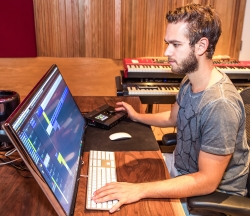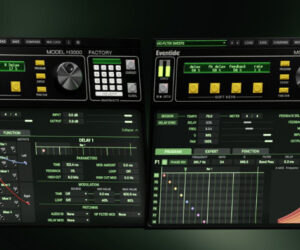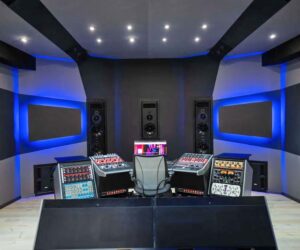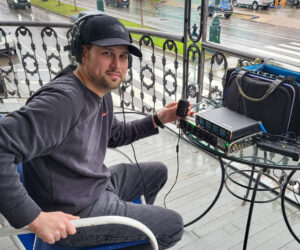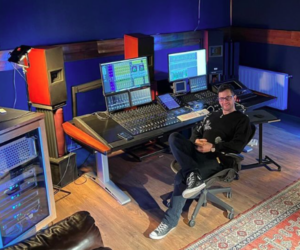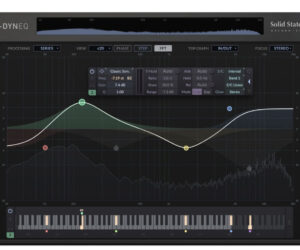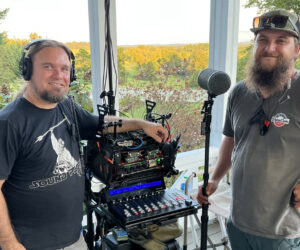Though producer, DJ, and multi-instrumentalist Zedd only began producing electronic music in 2009, his music quickly became a defining sound of contemporary electronic pop thanks to 2012’s “Clarity” and 2015’s “I Want You to Know.”
Having long used Antelope Audio clocking and conversion in his work, Zedd and his engineer had no trouble deciding on the Orion Studio when they decamped their operation to Zedd’s home. Since the studio’s completion, Antelope Audio’s single-rack-space USB+Thunderbolt interface has delivered everything Zedd needs to continue crafting synth-heavy pop.
The decision to build a home studio was triggered by an interruption at Zedd’s previous base of operations.
“Our studio at Interscope was being renovated, so after bouncing around to different studios for a while we ended up building a brand new studio at Zedd’s house,” says Zedd’s engineer Ryan Shanahan. “We had been using the original Antelope Audio Orion since the second half of the production of Clarity and we used it for all of True Colors, so stepping into an Orion Studio was a no brainer.”
Zedd and Shanahan envisioned the new studio as a space that would be ready to go as a creative workstation at all times. That meant taking advantage of the full 12 inputs offered on the Orion Studio. “His main keyboards are patched right into the 8 inputs on the back,” Shanahan explains. “We have one of the front inputs set up with a vocal chain and we leave the other 3 open to patch in anything else that Zedd might want to use.”
The Orion Studio’s 12 preamps give Shanahan the exact sound he wants for capturing the high-fidelity sheen of Zedd’s keys.
“The preamps are extremely clean and transparent, which is great for any source, especially the keyboards which constitute the bulk of our tracking,” he says. “I have digital emulations that I can always use with guitars or anything like that if I decide I want to add coloration later. I’m happy getting the cleanest possible signal when recording.” The high-quality monitor outputs also provide the perfect signal path to Zedd’s monitor controller.
Shanahan uses the routing afforded by the Orion Studio’s software to route incoming audio for monitoring just like he would on a console.
“When we’re working on a console we always monitor our input signals directly rather than monitoring back from the DAW so we don’t have latency,” he says. “With the Orion Studio software, I can set it up the same way by routing my inputs directly to the internal mixer and out to our monitoring controller. That not only ensures latency-free monitoring, but also allows Zedd to work out ideas on the piano anytime without even having to open up a session in the DAW.”
Shanahan has also taken advantage of some of the FPGA effects offered on the Orion Studio during tracking. Unlike processor-based plugins, FPGA technology provides true hardware modeling with near-zero latency.
“The Pultec and guitar cabinet emulations sounds really good, and I often use the built-in standard EQ and compressor to filter unwanted lows and glue things together a bit on the way in,” he says. “It’s really exciting that they keep releasing new FPGA models of classic hardware, I haven’t even had the chance to try out everything in Vintage Pack 2.0 yet.”
Above all, the Orion Studio provides conversion thanks to Antelope Audio’s fourth generation Acoustically Focused Clocking jitter management algorithm and oven-controlled crystal oscillator.
“I’ve always loved how the highs sound with Antelope clocking,” Shanahan says. “I feel like I’m getting more clarity in the frequency spectrum. The depth of the stereo image is very accurate and the transients are very sharp, so I’m really hearing what’s there.” This allows Zedd and Shanahan to push signals into clipping territory without fear of sacrificing quality. “We can hear how much we’re clipping and when it goes from musical to ugly. It’s gives a true picture of what we’re working with.”
“The Orion Studio is the perfect front end for Zedd’s workflow,” says Shanahan. “It’s really important to have a great converter, a great clock, and a great set of speakers. You can really hear the difference between Antelope Audio interfaces and others on the market.”


